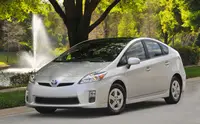HEELS ON WHEELS: 2010 Toyota Prius Review
MORE: Electric Vehicle News and Reviews - EV MOTORING
MORE: Toyota Specs, Comparisons and Prices - Toyota Buyers Guide
MORE: 100 2010 Toyota Prius Articles and Video
 |
By Katrina Ramser
San Francisco Bureau
The Auto Channel
Intro to the 2010 Toyota Prius
The Toyota Prius has now reached iconic status since the first model
entered the American market almost ten years ago, representing a positive
change for the way people think about transportation. There are currently
700,000 vehicles on US soil and 1.2 million worldwide. Recently, Toyota
launched a Certified Used Hybrid Program (TCUV) to further support the
technology and brand. By 2020, Toyota will have a hybrid model for every
single vehicle they manufacture.
During a media preview event, I was able to test-drive several of the 2010 Toyota Prius models with the all-new 134-horsepower 1.8-liter hybrid engine. There are four grade or trims: Prius II (standard); Prius III (better JBL audio system, Bluetooth); Pruis IV (adds upgraded and leather-trimmed interior, heated seats); and Prius V (adds 17-inch alloy wheels and LED headlamps and fog lamps). Available packages include the Navigation Package (voice-activated touch screen, backup camera, Safety Connect system); Solar Roof Package (solar-powered ventilation system and remote AC); and the Advance Technology Package (which includes a Lane Keep Assist, designed to correct steering off the road; and a Intelligent Park, where the car essentially parallel parks for you).
A price tag has yet to be determined. A total of 2,000 engineers worked on the 2010 Prius model and production will begin in Japan, late April, for consumer purchasing come this May. On a side note, the Prius finally gained a hybrid competitor – the Honda Insight, which is priced less.
HEELS ON WHEELS REVIEW CRITERIA
Stylish But Comfortable Results: The 2010 model is still the identifiable Prius – you will notice a tighter design flow on top, an extended rear spoiler, a larger lower grille and exaggerated, diamond-shaped taillights. The Prius is bigger, but not by much (about half-inch longer and three-quarters wider). Rear seats have almost a full inch of more knee space. The digital information display has several screen depths, creating a multi-layered look to flash vehicle stats for the convenience of the driver. There are now separate screens for audio and climate control – a huge plus in my book because it was work to control climate through a shared touch screen. In fact, it's the climate control that really dazzles. Heat from the solar paneling roof keeps the Prius at ambient temperatures, so the AC doesn't have to be in overdrive – and by the way, the key fob can click the AC on at remote distances.
Reliability & Safety Factor: The Pruis features seven standard airbags. Standard safety included anti-lock brakes (ABS), brake assist (BA), electronic-brake distribution (EBD), traction control (TRAC), and brake assist (BA). Hopefully Vehicle Stability Control (VSC) will be built into the standard price and not marketed as an optional extra.
Cost Issues: A price tag has yet to be determined. When the first Prius went on sale in the US, the MSPR was $19,995. A drove a 2008 with a $6,550 package including leather trimmed steering wheel and seats; voice-activated navigation system; Bluetooth; Vehicle Stability Control (VSC); auto-dimming rear mirror; Smart Key system; and fog lamps – the vehicle came to $27,899, and that's with a $2k discount.
Activity & Performance Ability: More than 90 percent of the hybrid synergy drive is newly developed. The larger 1.8-liter (up from the previous 1.5-liter) provides greater torque at lower rpms, working with a lighter transaxle that reduces torque loss by 20 percent. There is a new electric water pump that helps create a "belt-less" or no drive belt engine. Expect efficiency across the board – achieved through lower heat exhaust, better use of heat, and even stronger fuel consumption. The improved hybrid system also added driving modes – for example, the vehicle is fully capable of driving on electric only or using the EV Mode, which works for 1 mile if driving under 25-mph. The Eco Mode is for stop-and-go traffic – you can feel the throttle being conservatively managed for gas conservation. And finally, the Power Mode delivers better throttle response for a zip up steep hills. Power was steady and controlled – a noticeable difference.
The Green Concern: The 1.8-liter hybrid engine delivers 50-mpg. During a friendly competition between auto journalists to see who could get the best mileage, I was able to achieve 58-mpg, using a combination of the EV and hyper-miling techniques (slower driving, less acceleration on upgrades). Some of my colleagues boasted 75-mpg driving. The solar paneling is another way the Prius strives to be green (no AC overdrive).
FINAL PARTING WORDS
Toyota is the most leading, trusted and available brand in reliable
hybrid engine systems and the cult-like Prius crowd will be more than
pleased with both the subtle and significant improvements. Although the
price tag has not yet been determined, it is known the newest competitor
– the Honda Insight – is priced lower.
Katrina's Car Tips For Women Drivers
- Katrina's 2009 Crossover Watch List
- Katrina's 2009 3-Row SUVs and SUVs
- Katrina's 2008 Top 10 Vehicles For Female Drivers
- Katrina's Basic Car Insurance Coverage For Women
- Katrina's Money Saving Car Tips For Women
2010 and 2009 Model Reviews
- 2009 Acura RDX Review
- 2009 Acura TL Review
- 2009 Acura TSX Tech Review
- 2009 BMW X3 xDRIVE 30i Review
- 2009 Chevrolet Traverse Review
- 2009 Chevrolet Tahoe Hybrid Review
- 2009 Dodge Journey Review
- 2009 Ford Flex Review
- 2009 Honda Pilot EX-L Review
- 2009 Infiniti G37 Coupe Review
- 2009 Kia Borrego Review
- 2010 Lexus HS250h Review
- 2009 Mazda5 Grand Touring Review
- 2009 Mazda6 Grand Touring Review
- 2009 Mazda CX-9 Review
- 2009 Mercedes-Benz ML320 BLUETEC Review
- 2009 Mitsubishi Outlander Review
- 2009 Nissan Murano Review
- 2009 Suzuki Equator Review
- 2009 Subaru Forester Review
- 2010 Toyota Prius Hybrid Review
- 2009 Toyota Yaris Review
- 2009 Toyota Camry Hybrid Review
- 2009 Toyota RAV4 Review
- 2009 Volkswagen Tiguan SE 4Motion Review
- 2009 Volkswagen CC Sport Review
- 2009 Volkswagen Jetta Sportwagen TDI Review
2008 Model Reviews
- 2008 Buick Enclave Review
- 2008 Ford Escape
- 2008 Ford Escape Limited 4x4 Review
- 2008 Honda CR-V Review
- 2008 Honda Reidgeline Review
- 2008 Jeep Grand Cherokee SRT Review
- 2008 Kia Sportage 4x4 Review
- 2008 Lexus RX400h Hybrid Review
- 2008 Lexus GX470 Review
- 2008 Mercury Mariner Hybrid FWD Review
- 2008 Nissan Pathfinder Review
- 2008 Nissan Armada Review
- 2008 Suzuki SX4 Review
- 2008 Subaru Impreza WRX Review
- 2008 Toyota Prius Hybrid Review
- 2008 Toyota Land Cruiser Review
- 2008 Volkswagen Touareg Review
- 2008 Volkswagen Touareg Review
- 2008 Volvo C30 Review
©2009 Katrina Ramser
MORE: Electric Vehicle News and Reviews - EV MOTORING
MORE: Toyota Specs, Comparisons and Prices - Toyota Buyers Guide
MORE: 100 2010 Toyota Prius Articles and Video
MORE: 2010 Toyota Prius Specs and Dimensions(PDF)



